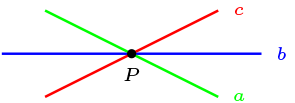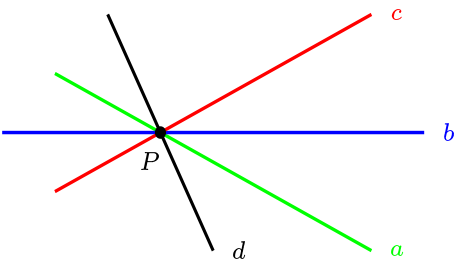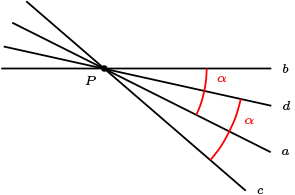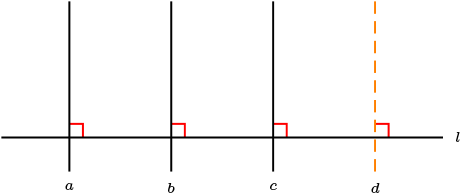Clausura Sean \(\sigma _1 , \sigma_2 \in G_P\text{,}\) luego existen \(a,b,c,d\in \mathcal{L}\) tales que \(P\mathcal{I}a,b,c,d\) y \(\sigma_1= R_a\circ R_b\text{,}\) \(\sigma_2= R_c\circ R_d\text{.}\)
Como \(P\mathcal{I}a,b,c\) y \(R_a\circ R_b \circ R_c\text{,}\) por teorema de las tres simetrías existe \(l \in \mathcal{L}\) tal que \(P\mathcal{I}l\) y \(R_a\circ R_b \circ R_c =R_l\text{.}\)
Luego tenemos que
\begin{equation*}
\sigma_1\circ \sigma_2= R_a\circ R_b\circ R_c\circ R_d= R_l\circ R_d \in G_P
\end{equation*}
Neutro Dada \(a\in \mathcal{L}\) tal que \(P\mathcal{I}a\) entonces \(R_a\circ R_a =Id \in G_P\text{.}\)
Inverso Sea \(\sigma= R_a\circ R_b \in G_P\text{,}\) luego
\begin{equation*}
\sigma^{-1}= R_b\circ R_a \in G_P
\end{equation*}
Conmutatividad Sean \(\sigma_1= R_a\circ R_b\text{,}\) \(\sigma_2= R_c\circ R_d\text{.}\) Por demostrar que
\begin{equation*}
\sigma_1\circ \sigma_2= \sigma_2\circ \sigma_1.
\end{equation*}
Por teorema de las tres simetrías tenemos que \(R_b\circ R_c \circ R_d =R_l\)
Luego \(\sigma_2 = R_b\circ R_l\text{.}\) De lo cual obtenemos
\begin{equation*}
\sigma_1\circ \sigma_2 = R_a\circ R_b\circ R_b\circ R_l =R_a\circ R_l
\end{equation*}
y
\begin{equation*}
\sigma_1\circ \sigma_2 = R_b\circ R_l \circ R_a \circ R_b
\end{equation*}
Reemplazando, obtenemos una proposición equivalente a que debemos demostrar
\begin{equation*}
R_a\circ R_l\circ R_b = R_b\circ R_l \circ R_a
\end{equation*}
Pero por teorema de las tres simetrías, es una simetría
\begin{equation*}
R_a\circ R_l\circ R_b = (R_a\circ R_l\circ R_b)^{-1}= R_b\circ R_l \circ R_a
\end{equation*}
lo que demuestra lo requerido.





